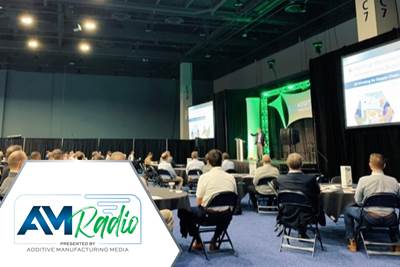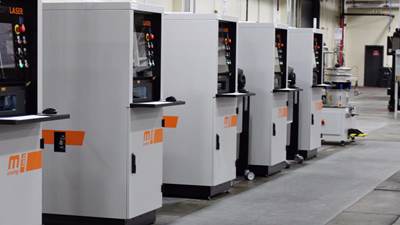Additive Manufacturing Is More Than 3D Printing: The Importance of Complementary Capabilities (Video)
Vertex Manufacturing founder Greg Morris on machining, inspection and other operations that complete AM.
Greg Morris has co-founded multiple companies succeeding with additive manufacturing. First was Morris Technologies, a pioneering AM firm acquired by GE. Today he helps to lead Vertex Manufacturing, a contract manufacturer that is a part of PrinterPrezz and succeeds in production 3D printing along with various forms of CNC machining. In winning opportunities for AM, Morris discusses how valuable it is to have a variety of capabilities available under one roof. This clip is part of his conversation onstage with me at the Additive Manufacturing Conference in 2021.
Editor’s note: Vertex Manufacturing and PrinterPrezz are now part of Zeda, Inc.
Transcript
Peter Zelinski
You open this business and there's there's a spectrum of manufacturing capabilities there. Pretty significant CNC machining capability. It wasn't a given that the opportunities that would come to you are additive. But those kinds of opportunities have come. And as you say, you tried not to be Morris Technologies 2.0, those opportunities have come probably partly because of your reputation. But also kind of because what you started to hint at there, which is all the other capabilities you have, in addition to additive. So I guess talk about that a little bit, how important is it and how helpful, reassuring, comforting is that to the customer to who's got an additive part, but also sees all this other stuff that you can also do under the same roof.
Greg Morris
A lot has changed from when I was actively involved day to day at Morris Tech to where we are today at Vertex. But one constant has remained and that is that I think having a broader capability to bring to customers, not just hey, I grow apart and I can do some basic machining, I think having that broader palette to be able to pull from and say I can take care of all that post-machining or finishing or inspection is pretty important. Now, to some degree, and I still think this is the case, it was the case before it's the case today, a lot of that can become pretty transparent. So it's not always something that people would associate when they send a print, if you will, or a file and say I need this to these dimensions and with all the specs. It's not always apparent what the multiple steps might be. And it also depends on the type of work. We're involved in a lot of development and R&D, although we do certainly want to and are involved in production, higher volume production stuff as well. So I think it really depends on the type of work that we're doing as to how much you you dip into some of those specialty processes. For instance, if you're using an example of a high pressure turbine blade, and you want to grow it, in fact, picture of one on the screen, if you want to grow that high pressure turbine blade, and you want to get those air passages opened up, because you have a certain flow that's on the print, you're probably going to need to extrude home to open those passages up. There's ways to do it but the extrude home would be a good option. So if you're doing that you have to have that specialized piece of equipment or find somebody on the outside that has it and that's difficult for some of these. So I would say most people would say just deliver with the flow that I need and we take care of trying to figure all that out.
Peter Zelinski
Okay, so I guess I asked the question in terms of does the range of capabilities bring comfort to the customer and it's not exactly that. It's more that they are apt to present you with this challenging thing and they don't know where the challenges are. And there's more you can say yes to pretty confidently because of the range of capabilities.
Greg Morris
I think that's a fair statement. So clearly we've lived a lot of those challenges of how do you just handle from build to final part, and there are many, many steps as most everybody who's involved in the industry recognize. So that's not just the build and successful build and trying to make sure you don't have issues. It's the post thermal processing, it's the support removal, it's the post machining, it's the post surface finishing it's the post inspection. So yeah, I think having all that under roof is very helpful. But sometimes people get that and many times they don't and I think that's one of the - Still today one of the items that is a little surprising is that not everybody fully grasps and understands the depth of what you might have to do in order to successfully produce a part. Which you would think at this point maybe that would be there, but you know, it just hasn't totally filtered down.
Related Content
3D Printing with Plastic Pellets – What You Need to Know
A few 3D printers today are capable of working directly with resin pellets for feedstock. That brings extreme flexibility in material options, but also requires greater knowledge of how to best process any given resin. Here’s how FGF machine maker JuggerBot 3D addresses both the printing technology and the process know-how.
Read More3D Printed Titanium Replaces Aluminum for Unmanned Aircraft Wing Splice: The Cool Parts Show #72
Rapid Plasma Deposition produces the near-net-shape preform for a newly designed wing splice for remotely piloted aircraft from General Atomics. The Cool Parts Show visits Norsk Titanium, where this part is made.
Read MoreAt General Atomics, Do Unmanned Aerial Systems Reveal the Future of Aircraft Manufacturing?
The maker of the Predator and SkyGuardian remote aircraft can implement additive manufacturing more rapidly and widely than the makers of other types of planes. The role of 3D printing in current and future UAS components hints at how far AM can go to save cost and time in aircraft production and design.
Read MoreTwo 12-Laser AM Machines at Collins Aerospace: Here Is How They Are Being Used
With this additive manufacturing capacity, one room of the Collins Iowa facility performs the work previously requiring a supply chain. Production yield will nearly double, and lead times will be more than 80% shorter.
Read MoreRead Next
Recapping the 2021 Additive Manufacturing Conference + Expo: AM Radio #5
The program covered everything from tooling to personnel challenges involved in implementing additive. Peter Zelinski, Stephanie Hendrixson and Julia Hider recap the event.
Read MoreAdditive Manufacturing and 3D Printing Are Two Different Things
And as AM continues to advance, the differences are becoming more pronounced and more important.
Read More


















